Theories of Leadership, Management, and Communication in Business
VerifiedAdded on 2022/08/27
|25
|5391
|15
Homework Assignment
AI Summary
This assignment provides a comprehensive exploration of leadership and management principles within an organizational context. It begins by differentiating between leadership and management, analyzing various theories that highlight their distinct characteristics and approaches. The assignment delves into motivational theories, particularly Maslow's Need Hierarchy and Herzberg's Two-Factor Theory, examining how these frameworks influence employee behavior and productivity. Furthermore, it investigates the dynamics of communication within organizations, dissecting formal and informal communication networks and their impact on information flow. The study includes a real-life case study demonstrating the application of leadership skills in organizational recovery, along with a comparison of synchronous and asynchronous communication methods. Finally, the assignment concludes with an analysis of Mintzberg's ten managerial roles, providing a holistic view of the multifaceted responsibilities of managers in their working lives. The assignment covers topics such as trait theory, Katz Framework, and different behavior of leadership, and includes an abstract, key points, examples, suggestions, and bibliography for each question.
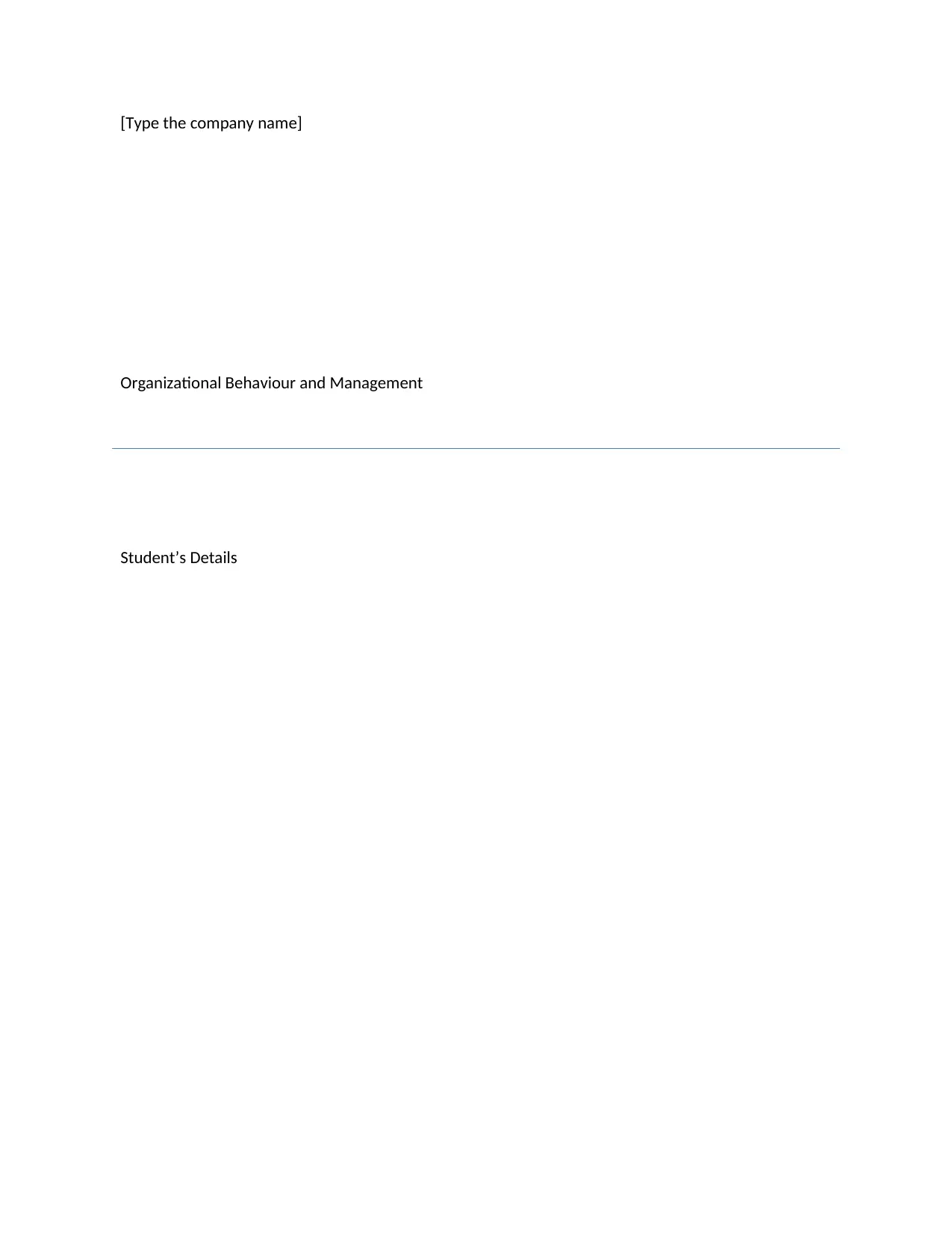
[Type the company name]
Organizational Behaviour and Management
Student’s Details
Organizational Behaviour and Management
Student’s Details
Paraphrase This Document
Need a fresh take? Get an instant paraphrase of this document with our AI Paraphraser
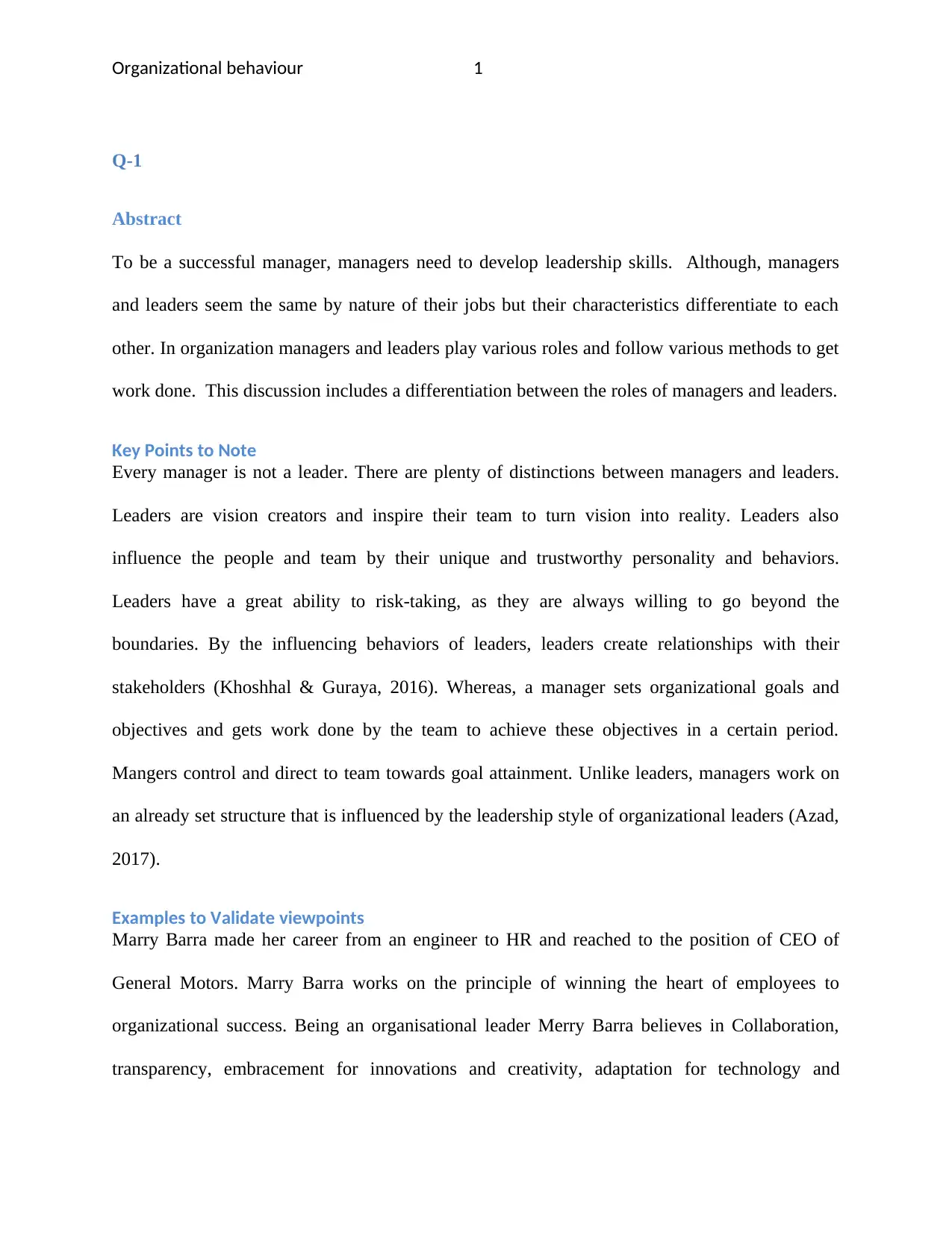
Organizational behaviour 1
Q-1
Abstract
To be a successful manager, managers need to develop leadership skills. Although, managers
and leaders seem the same by nature of their jobs but their characteristics differentiate to each
other. In organization managers and leaders play various roles and follow various methods to get
work done. This discussion includes a differentiation between the roles of managers and leaders.
Key Points to Note
Every manager is not a leader. There are plenty of distinctions between managers and leaders.
Leaders are vision creators and inspire their team to turn vision into reality. Leaders also
influence the people and team by their unique and trustworthy personality and behaviors.
Leaders have a great ability to risk-taking, as they are always willing to go beyond the
boundaries. By the influencing behaviors of leaders, leaders create relationships with their
stakeholders (Khoshhal & Guraya, 2016). Whereas, a manager sets organizational goals and
objectives and gets work done by the team to achieve these objectives in a certain period.
Mangers control and direct to team towards goal attainment. Unlike leaders, managers work on
an already set structure that is influenced by the leadership style of organizational leaders (Azad,
2017).
Examples to Validate viewpoints
Marry Barra made her career from an engineer to HR and reached to the position of CEO of
General Motors. Marry Barra works on the principle of winning the heart of employees to
organizational success. Being an organisational leader Merry Barra believes in Collaboration,
transparency, embracement for innovations and creativity, adaptation for technology and
Q-1
Abstract
To be a successful manager, managers need to develop leadership skills. Although, managers
and leaders seem the same by nature of their jobs but their characteristics differentiate to each
other. In organization managers and leaders play various roles and follow various methods to get
work done. This discussion includes a differentiation between the roles of managers and leaders.
Key Points to Note
Every manager is not a leader. There are plenty of distinctions between managers and leaders.
Leaders are vision creators and inspire their team to turn vision into reality. Leaders also
influence the people and team by their unique and trustworthy personality and behaviors.
Leaders have a great ability to risk-taking, as they are always willing to go beyond the
boundaries. By the influencing behaviors of leaders, leaders create relationships with their
stakeholders (Khoshhal & Guraya, 2016). Whereas, a manager sets organizational goals and
objectives and gets work done by the team to achieve these objectives in a certain period.
Mangers control and direct to team towards goal attainment. Unlike leaders, managers work on
an already set structure that is influenced by the leadership style of organizational leaders (Azad,
2017).
Examples to Validate viewpoints
Marry Barra made her career from an engineer to HR and reached to the position of CEO of
General Motors. Marry Barra works on the principle of winning the heart of employees to
organizational success. Being an organisational leader Merry Barra believes in Collaboration,
transparency, embracement for innovations and creativity, adaptation for technology and
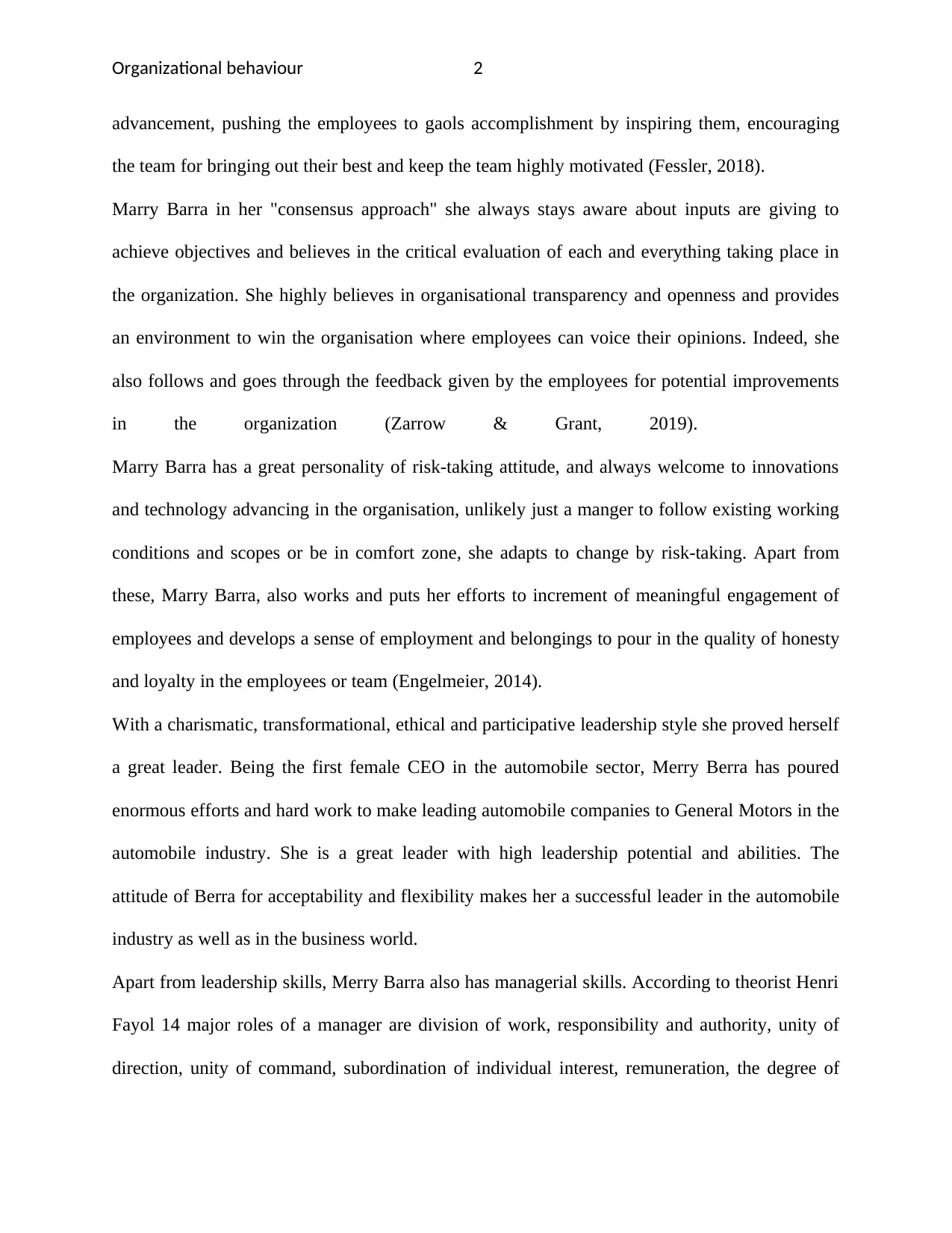
Organizational behaviour 2
advancement, pushing the employees to gaols accomplishment by inspiring them, encouraging
the team for bringing out their best and keep the team highly motivated (Fessler, 2018).
Marry Barra in her "consensus approach" she always stays aware about inputs are giving to
achieve objectives and believes in the critical evaluation of each and everything taking place in
the organization. She highly believes in organisational transparency and openness and provides
an environment to win the organisation where employees can voice their opinions. Indeed, she
also follows and goes through the feedback given by the employees for potential improvements
in the organization (Zarrow & Grant, 2019).
Marry Barra has a great personality of risk-taking attitude, and always welcome to innovations
and technology advancing in the organisation, unlikely just a manger to follow existing working
conditions and scopes or be in comfort zone, she adapts to change by risk-taking. Apart from
these, Marry Barra, also works and puts her efforts to increment of meaningful engagement of
employees and develops a sense of employment and belongings to pour in the quality of honesty
and loyalty in the employees or team (Engelmeier, 2014).
With a charismatic, transformational, ethical and participative leadership style she proved herself
a great leader. Being the first female CEO in the automobile sector, Merry Berra has poured
enormous efforts and hard work to make leading automobile companies to General Motors in the
automobile industry. She is a great leader with high leadership potential and abilities. The
attitude of Berra for acceptability and flexibility makes her a successful leader in the automobile
industry as well as in the business world.
Apart from leadership skills, Merry Barra also has managerial skills. According to theorist Henri
Fayol 14 major roles of a manager are division of work, responsibility and authority, unity of
direction, unity of command, subordination of individual interest, remuneration, the degree of
advancement, pushing the employees to gaols accomplishment by inspiring them, encouraging
the team for bringing out their best and keep the team highly motivated (Fessler, 2018).
Marry Barra in her "consensus approach" she always stays aware about inputs are giving to
achieve objectives and believes in the critical evaluation of each and everything taking place in
the organization. She highly believes in organisational transparency and openness and provides
an environment to win the organisation where employees can voice their opinions. Indeed, she
also follows and goes through the feedback given by the employees for potential improvements
in the organization (Zarrow & Grant, 2019).
Marry Barra has a great personality of risk-taking attitude, and always welcome to innovations
and technology advancing in the organisation, unlikely just a manger to follow existing working
conditions and scopes or be in comfort zone, she adapts to change by risk-taking. Apart from
these, Marry Barra, also works and puts her efforts to increment of meaningful engagement of
employees and develops a sense of employment and belongings to pour in the quality of honesty
and loyalty in the employees or team (Engelmeier, 2014).
With a charismatic, transformational, ethical and participative leadership style she proved herself
a great leader. Being the first female CEO in the automobile sector, Merry Berra has poured
enormous efforts and hard work to make leading automobile companies to General Motors in the
automobile industry. She is a great leader with high leadership potential and abilities. The
attitude of Berra for acceptability and flexibility makes her a successful leader in the automobile
industry as well as in the business world.
Apart from leadership skills, Merry Barra also has managerial skills. According to theorist Henri
Fayol 14 major roles of a manager are division of work, responsibility and authority, unity of
direction, unity of command, subordination of individual interest, remuneration, the degree of
⊘ This is a preview!⊘
Do you want full access?
Subscribe today to unlock all pages.

Trusted by 1+ million students worldwide
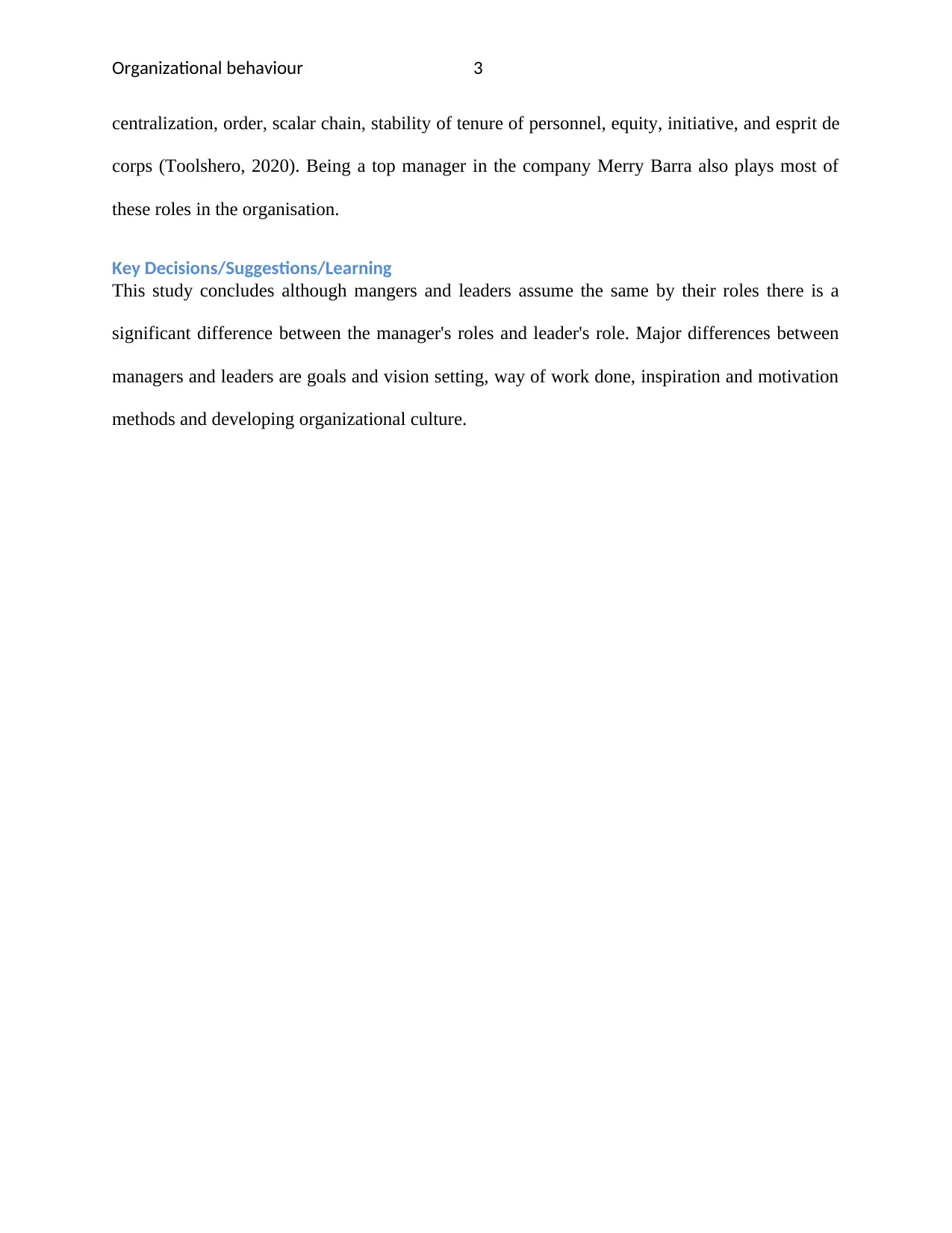
Organizational behaviour 3
centralization, order, scalar chain, stability of tenure of personnel, equity, initiative, and esprit de
corps (Toolshero, 2020). Being a top manager in the company Merry Barra also plays most of
these roles in the organisation.
Key Decisions/Suggestions/Learning
This study concludes although mangers and leaders assume the same by their roles there is a
significant difference between the manager's roles and leader's role. Major differences between
managers and leaders are goals and vision setting, way of work done, inspiration and motivation
methods and developing organizational culture.
centralization, order, scalar chain, stability of tenure of personnel, equity, initiative, and esprit de
corps (Toolshero, 2020). Being a top manager in the company Merry Barra also plays most of
these roles in the organisation.
Key Decisions/Suggestions/Learning
This study concludes although mangers and leaders assume the same by their roles there is a
significant difference between the manager's roles and leader's role. Major differences between
managers and leaders are goals and vision setting, way of work done, inspiration and motivation
methods and developing organizational culture.
Paraphrase This Document
Need a fresh take? Get an instant paraphrase of this document with our AI Paraphraser
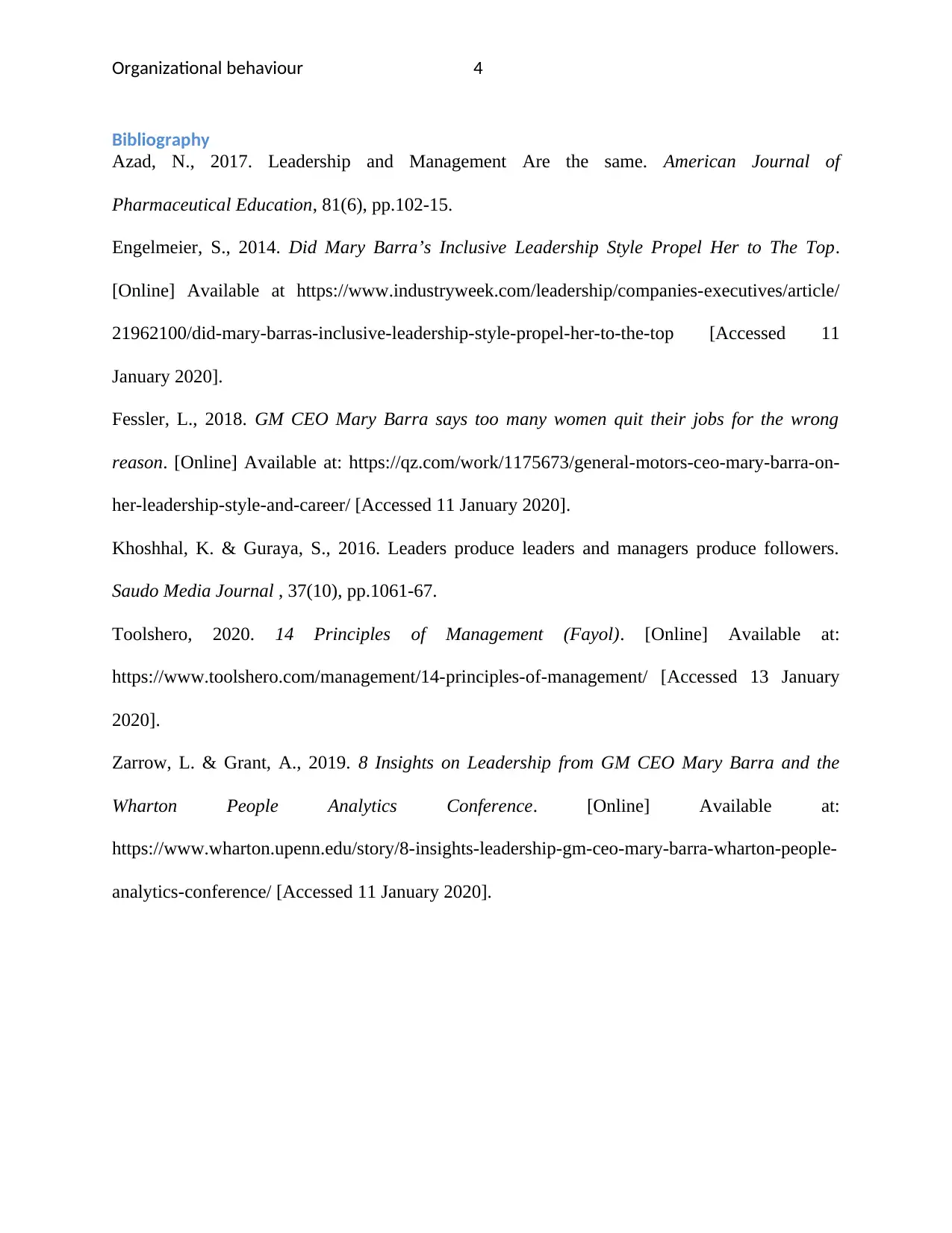
Organizational behaviour 4
Bibliography
Azad, N., 2017. Leadership and Management Are the same. American Journal of
Pharmaceutical Education, 81(6), pp.102-15.
Engelmeier, S., 2014. Did Mary Barra’s Inclusive Leadership Style Propel Her to The Top.
[Online] Available at https://www.industryweek.com/leadership/companies-executives/article/
21962100/did-mary-barras-inclusive-leadership-style-propel-her-to-the-top [Accessed 11
January 2020].
Fessler, L., 2018. GM CEO Mary Barra says too many women quit their jobs for the wrong
reason. [Online] Available at: https://qz.com/work/1175673/general-motors-ceo-mary-barra-on-
her-leadership-style-and-career/ [Accessed 11 January 2020].
Khoshhal, K. & Guraya, S., 2016. Leaders produce leaders and managers produce followers.
Saudo Media Journal , 37(10), pp.1061-67.
Toolshero, 2020. 14 Principles of Management (Fayol). [Online] Available at:
https://www.toolshero.com/management/14-principles-of-management/ [Accessed 13 January
2020].
Zarrow, L. & Grant, A., 2019. 8 Insights on Leadership from GM CEO Mary Barra and the
Wharton People Analytics Conference. [Online] Available at:
https://www.wharton.upenn.edu/story/8-insights-leadership-gm-ceo-mary-barra-wharton-people-
analytics-conference/ [Accessed 11 January 2020].
Bibliography
Azad, N., 2017. Leadership and Management Are the same. American Journal of
Pharmaceutical Education, 81(6), pp.102-15.
Engelmeier, S., 2014. Did Mary Barra’s Inclusive Leadership Style Propel Her to The Top.
[Online] Available at https://www.industryweek.com/leadership/companies-executives/article/
21962100/did-mary-barras-inclusive-leadership-style-propel-her-to-the-top [Accessed 11
January 2020].
Fessler, L., 2018. GM CEO Mary Barra says too many women quit their jobs for the wrong
reason. [Online] Available at: https://qz.com/work/1175673/general-motors-ceo-mary-barra-on-
her-leadership-style-and-career/ [Accessed 11 January 2020].
Khoshhal, K. & Guraya, S., 2016. Leaders produce leaders and managers produce followers.
Saudo Media Journal , 37(10), pp.1061-67.
Toolshero, 2020. 14 Principles of Management (Fayol). [Online] Available at:
https://www.toolshero.com/management/14-principles-of-management/ [Accessed 13 January
2020].
Zarrow, L. & Grant, A., 2019. 8 Insights on Leadership from GM CEO Mary Barra and the
Wharton People Analytics Conference. [Online] Available at:
https://www.wharton.upenn.edu/story/8-insights-leadership-gm-ceo-mary-barra-wharton-people-
analytics-conference/ [Accessed 11 January 2020].
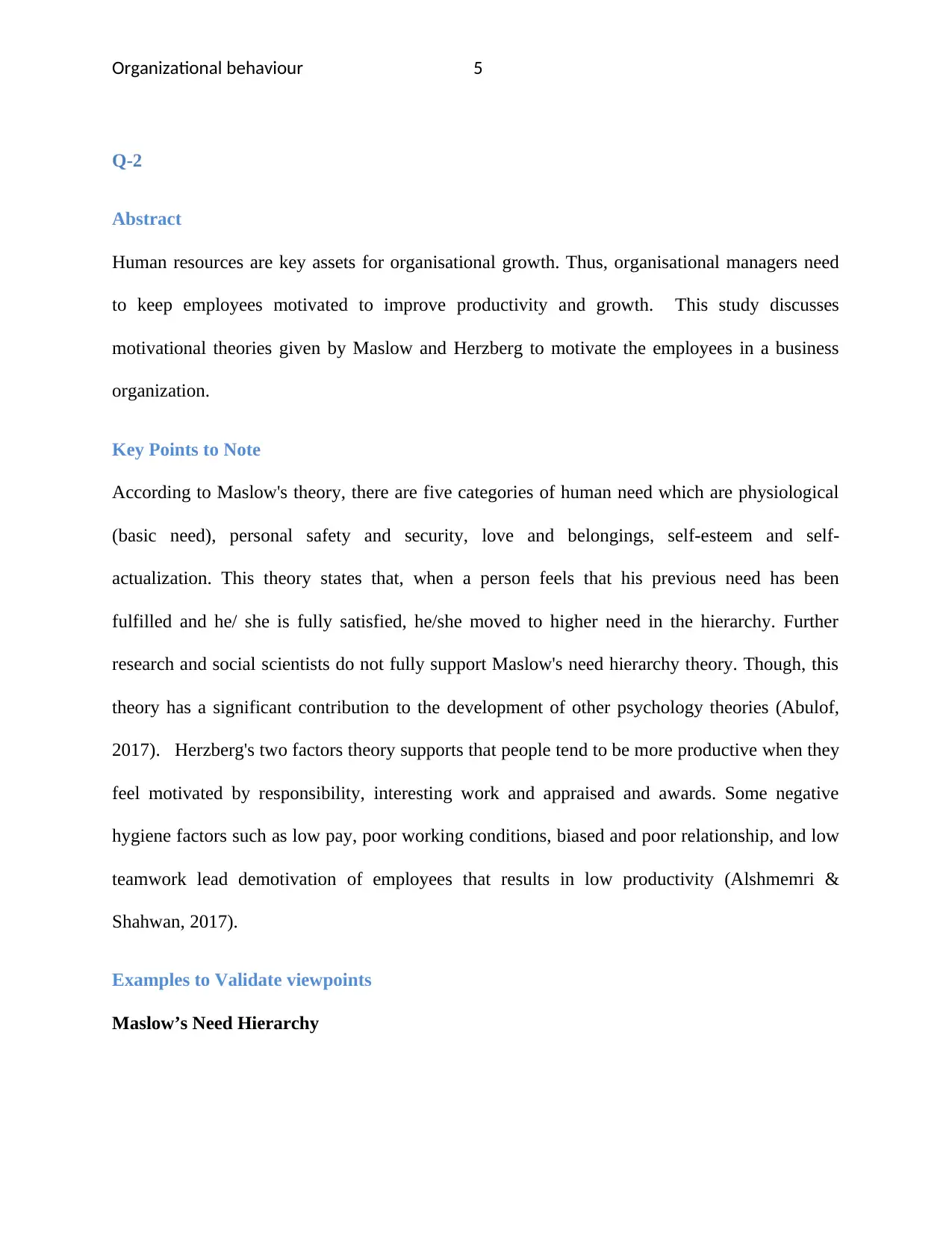
Organizational behaviour 5
Q-2
Abstract
Human resources are key assets for organisational growth. Thus, organisational managers need
to keep employees motivated to improve productivity and growth. This study discusses
motivational theories given by Maslow and Herzberg to motivate the employees in a business
organization.
Key Points to Note
According to Maslow's theory, there are five categories of human need which are physiological
(basic need), personal safety and security, love and belongings, self-esteem and self-
actualization. This theory states that, when a person feels that his previous need has been
fulfilled and he/ she is fully satisfied, he/she moved to higher need in the hierarchy. Further
research and social scientists do not fully support Maslow's need hierarchy theory. Though, this
theory has a significant contribution to the development of other psychology theories (Abulof,
2017). Herzberg's two factors theory supports that people tend to be more productive when they
feel motivated by responsibility, interesting work and appraised and awards. Some negative
hygiene factors such as low pay, poor working conditions, biased and poor relationship, and low
teamwork lead demotivation of employees that results in low productivity (Alshmemri &
Shahwan, 2017).
Examples to Validate viewpoints
Maslow’s Need Hierarchy
Q-2
Abstract
Human resources are key assets for organisational growth. Thus, organisational managers need
to keep employees motivated to improve productivity and growth. This study discusses
motivational theories given by Maslow and Herzberg to motivate the employees in a business
organization.
Key Points to Note
According to Maslow's theory, there are five categories of human need which are physiological
(basic need), personal safety and security, love and belongings, self-esteem and self-
actualization. This theory states that, when a person feels that his previous need has been
fulfilled and he/ she is fully satisfied, he/she moved to higher need in the hierarchy. Further
research and social scientists do not fully support Maslow's need hierarchy theory. Though, this
theory has a significant contribution to the development of other psychology theories (Abulof,
2017). Herzberg's two factors theory supports that people tend to be more productive when they
feel motivated by responsibility, interesting work and appraised and awards. Some negative
hygiene factors such as low pay, poor working conditions, biased and poor relationship, and low
teamwork lead demotivation of employees that results in low productivity (Alshmemri &
Shahwan, 2017).
Examples to Validate viewpoints
Maslow’s Need Hierarchy
⊘ This is a preview!⊘
Do you want full access?
Subscribe today to unlock all pages.

Trusted by 1+ million students worldwide
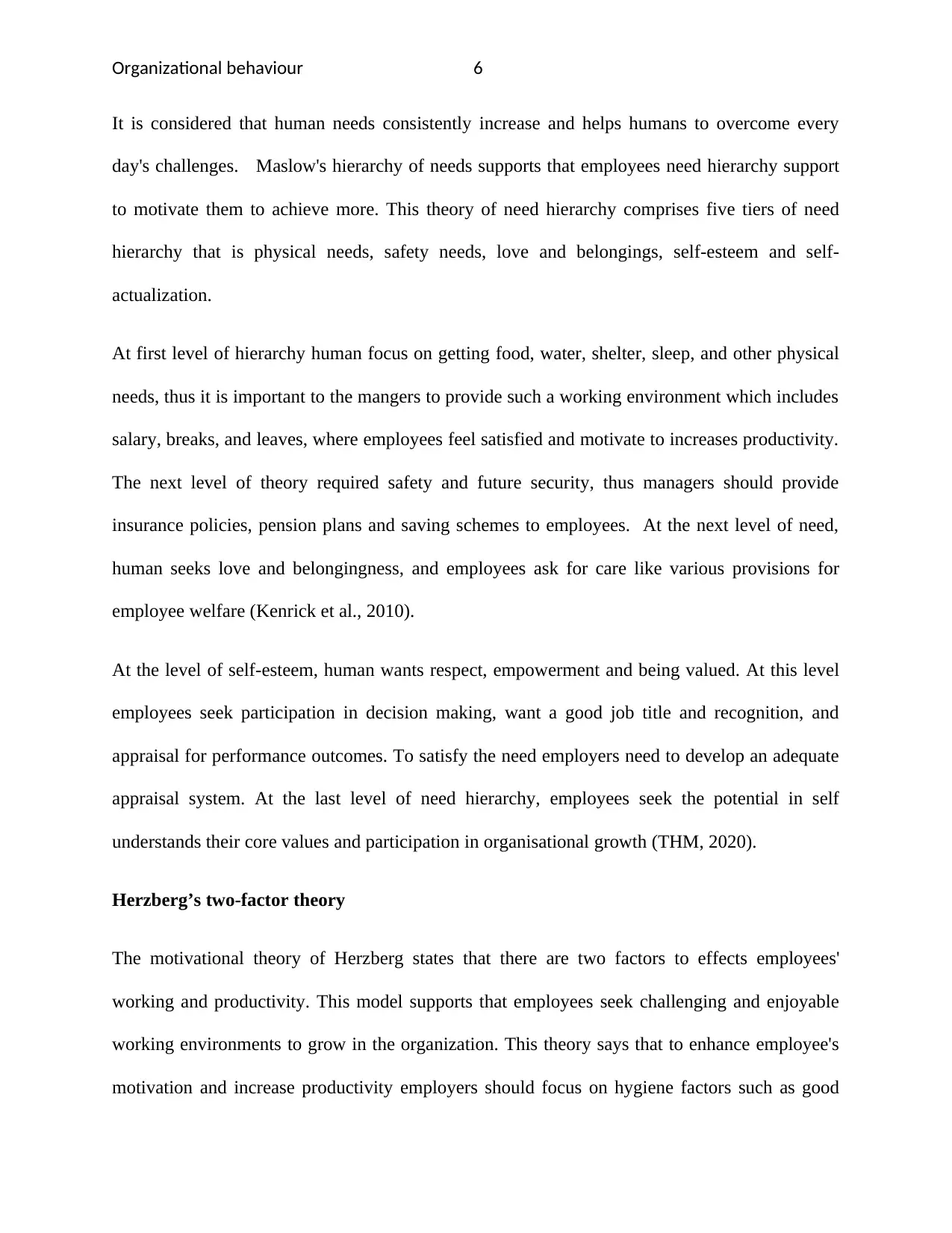
Organizational behaviour 6
It is considered that human needs consistently increase and helps humans to overcome every
day's challenges. Maslow's hierarchy of needs supports that employees need hierarchy support
to motivate them to achieve more. This theory of need hierarchy comprises five tiers of need
hierarchy that is physical needs, safety needs, love and belongings, self-esteem and self-
actualization.
At first level of hierarchy human focus on getting food, water, shelter, sleep, and other physical
needs, thus it is important to the mangers to provide such a working environment which includes
salary, breaks, and leaves, where employees feel satisfied and motivate to increases productivity.
The next level of theory required safety and future security, thus managers should provide
insurance policies, pension plans and saving schemes to employees. At the next level of need,
human seeks love and belongingness, and employees ask for care like various provisions for
employee welfare (Kenrick et al., 2010).
At the level of self-esteem, human wants respect, empowerment and being valued. At this level
employees seek participation in decision making, want a good job title and recognition, and
appraisal for performance outcomes. To satisfy the need employers need to develop an adequate
appraisal system. At the last level of need hierarchy, employees seek the potential in self
understands their core values and participation in organisational growth (THM, 2020).
Herzberg’s two-factor theory
The motivational theory of Herzberg states that there are two factors to effects employees'
working and productivity. This model supports that employees seek challenging and enjoyable
working environments to grow in the organization. This theory says that to enhance employee's
motivation and increase productivity employers should focus on hygiene factors such as good
It is considered that human needs consistently increase and helps humans to overcome every
day's challenges. Maslow's hierarchy of needs supports that employees need hierarchy support
to motivate them to achieve more. This theory of need hierarchy comprises five tiers of need
hierarchy that is physical needs, safety needs, love and belongings, self-esteem and self-
actualization.
At first level of hierarchy human focus on getting food, water, shelter, sleep, and other physical
needs, thus it is important to the mangers to provide such a working environment which includes
salary, breaks, and leaves, where employees feel satisfied and motivate to increases productivity.
The next level of theory required safety and future security, thus managers should provide
insurance policies, pension plans and saving schemes to employees. At the next level of need,
human seeks love and belongingness, and employees ask for care like various provisions for
employee welfare (Kenrick et al., 2010).
At the level of self-esteem, human wants respect, empowerment and being valued. At this level
employees seek participation in decision making, want a good job title and recognition, and
appraisal for performance outcomes. To satisfy the need employers need to develop an adequate
appraisal system. At the last level of need hierarchy, employees seek the potential in self
understands their core values and participation in organisational growth (THM, 2020).
Herzberg’s two-factor theory
The motivational theory of Herzberg states that there are two factors to effects employees'
working and productivity. This model supports that employees seek challenging and enjoyable
working environments to grow in the organization. This theory says that to enhance employee's
motivation and increase productivity employers should focus on hygiene factors such as good
Paraphrase This Document
Need a fresh take? Get an instant paraphrase of this document with our AI Paraphraser
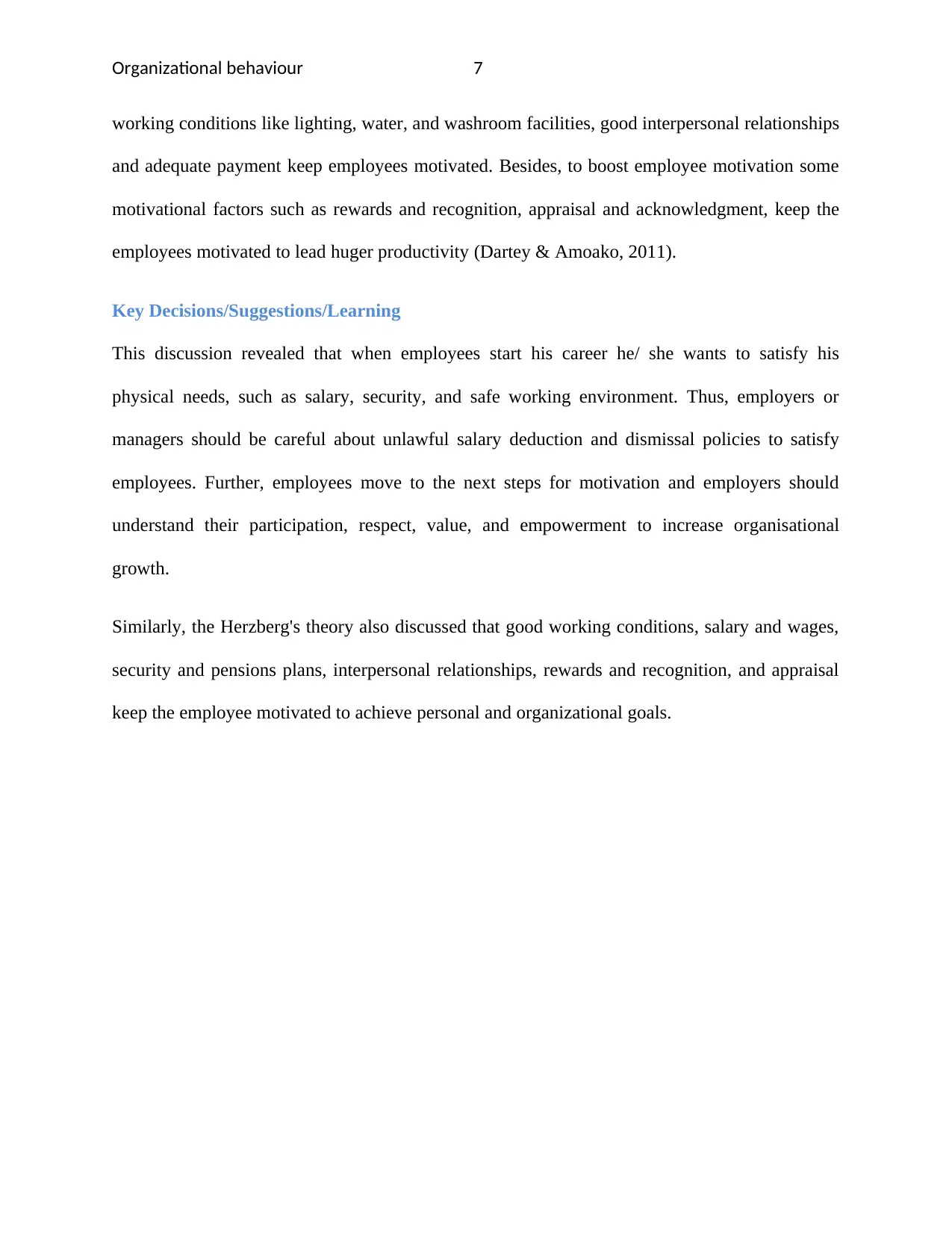
Organizational behaviour 7
working conditions like lighting, water, and washroom facilities, good interpersonal relationships
and adequate payment keep employees motivated. Besides, to boost employee motivation some
motivational factors such as rewards and recognition, appraisal and acknowledgment, keep the
employees motivated to lead huger productivity (Dartey & Amoako, 2011).
Key Decisions/Suggestions/Learning
This discussion revealed that when employees start his career he/ she wants to satisfy his
physical needs, such as salary, security, and safe working environment. Thus, employers or
managers should be careful about unlawful salary deduction and dismissal policies to satisfy
employees. Further, employees move to the next steps for motivation and employers should
understand their participation, respect, value, and empowerment to increase organisational
growth.
Similarly, the Herzberg's theory also discussed that good working conditions, salary and wages,
security and pensions plans, interpersonal relationships, rewards and recognition, and appraisal
keep the employee motivated to achieve personal and organizational goals.
working conditions like lighting, water, and washroom facilities, good interpersonal relationships
and adequate payment keep employees motivated. Besides, to boost employee motivation some
motivational factors such as rewards and recognition, appraisal and acknowledgment, keep the
employees motivated to lead huger productivity (Dartey & Amoako, 2011).
Key Decisions/Suggestions/Learning
This discussion revealed that when employees start his career he/ she wants to satisfy his
physical needs, such as salary, security, and safe working environment. Thus, employers or
managers should be careful about unlawful salary deduction and dismissal policies to satisfy
employees. Further, employees move to the next steps for motivation and employers should
understand their participation, respect, value, and empowerment to increase organisational
growth.
Similarly, the Herzberg's theory also discussed that good working conditions, salary and wages,
security and pensions plans, interpersonal relationships, rewards and recognition, and appraisal
keep the employee motivated to achieve personal and organizational goals.
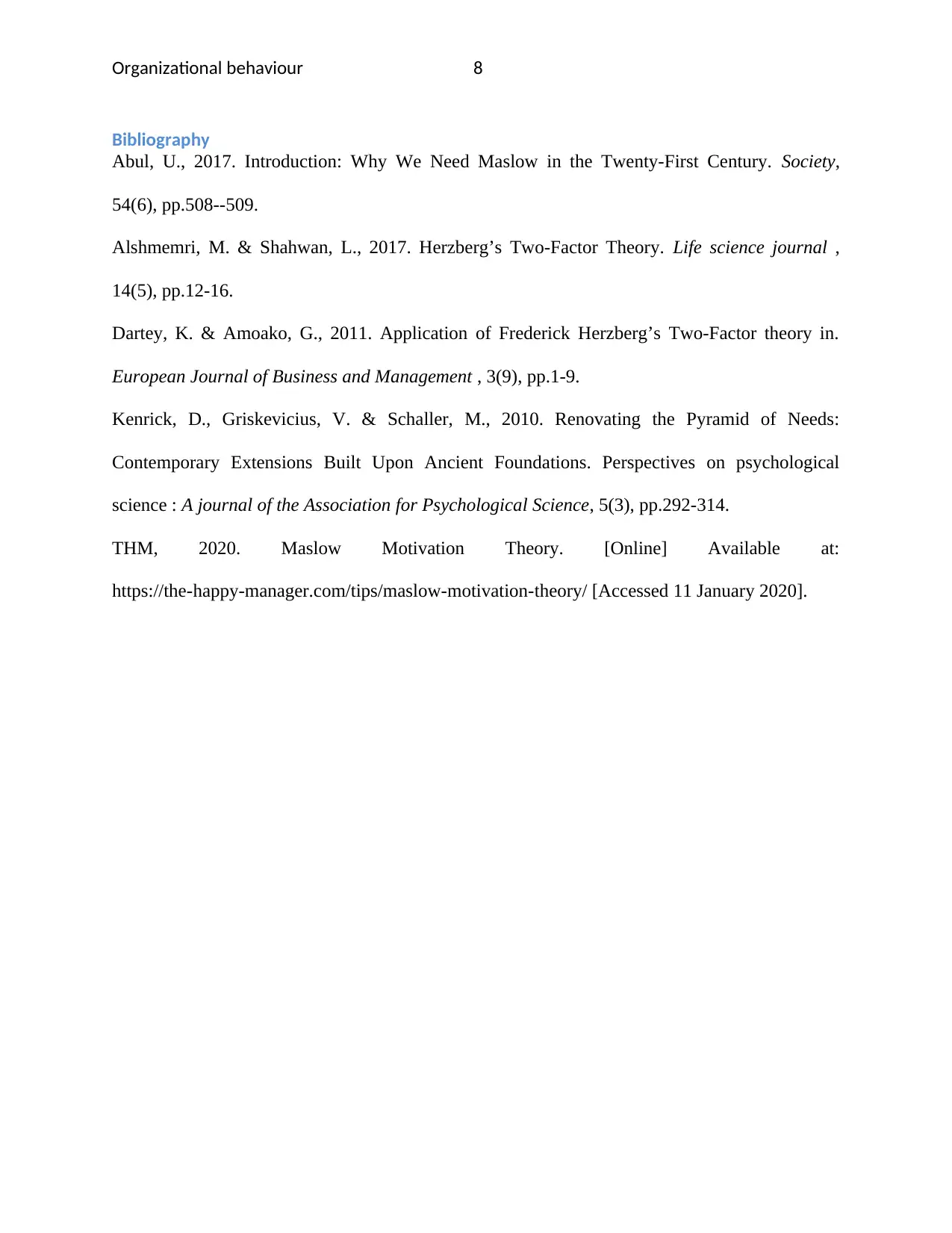
Organizational behaviour 8
Bibliography
Abul, U., 2017. Introduction: Why We Need Maslow in the Twenty-First Century. Society,
54(6), pp.508--509.
Alshmemri, M. & Shahwan, L., 2017. Herzberg’s Two-Factor Theory. Life science journal ,
14(5), pp.12-16.
Dartey, K. & Amoako, G., 2011. Application of Frederick Herzberg’s Two-Factor theory in.
European Journal of Business and Management , 3(9), pp.1-9.
Kenrick, D., Griskevicius, V. & Schaller, M., 2010. Renovating the Pyramid of Needs:
Contemporary Extensions Built Upon Ancient Foundations. Perspectives on psychological
science : A journal of the Association for Psychological Science, 5(3), pp.292-314.
THM, 2020. Maslow Motivation Theory. [Online] Available at:
https://the-happy-manager.com/tips/maslow-motivation-theory/ [Accessed 11 January 2020].
Bibliography
Abul, U., 2017. Introduction: Why We Need Maslow in the Twenty-First Century. Society,
54(6), pp.508--509.
Alshmemri, M. & Shahwan, L., 2017. Herzberg’s Two-Factor Theory. Life science journal ,
14(5), pp.12-16.
Dartey, K. & Amoako, G., 2011. Application of Frederick Herzberg’s Two-Factor theory in.
European Journal of Business and Management , 3(9), pp.1-9.
Kenrick, D., Griskevicius, V. & Schaller, M., 2010. Renovating the Pyramid of Needs:
Contemporary Extensions Built Upon Ancient Foundations. Perspectives on psychological
science : A journal of the Association for Psychological Science, 5(3), pp.292-314.
THM, 2020. Maslow Motivation Theory. [Online] Available at:
https://the-happy-manager.com/tips/maslow-motivation-theory/ [Accessed 11 January 2020].
⊘ This is a preview!⊘
Do you want full access?
Subscribe today to unlock all pages.

Trusted by 1+ million students worldwide
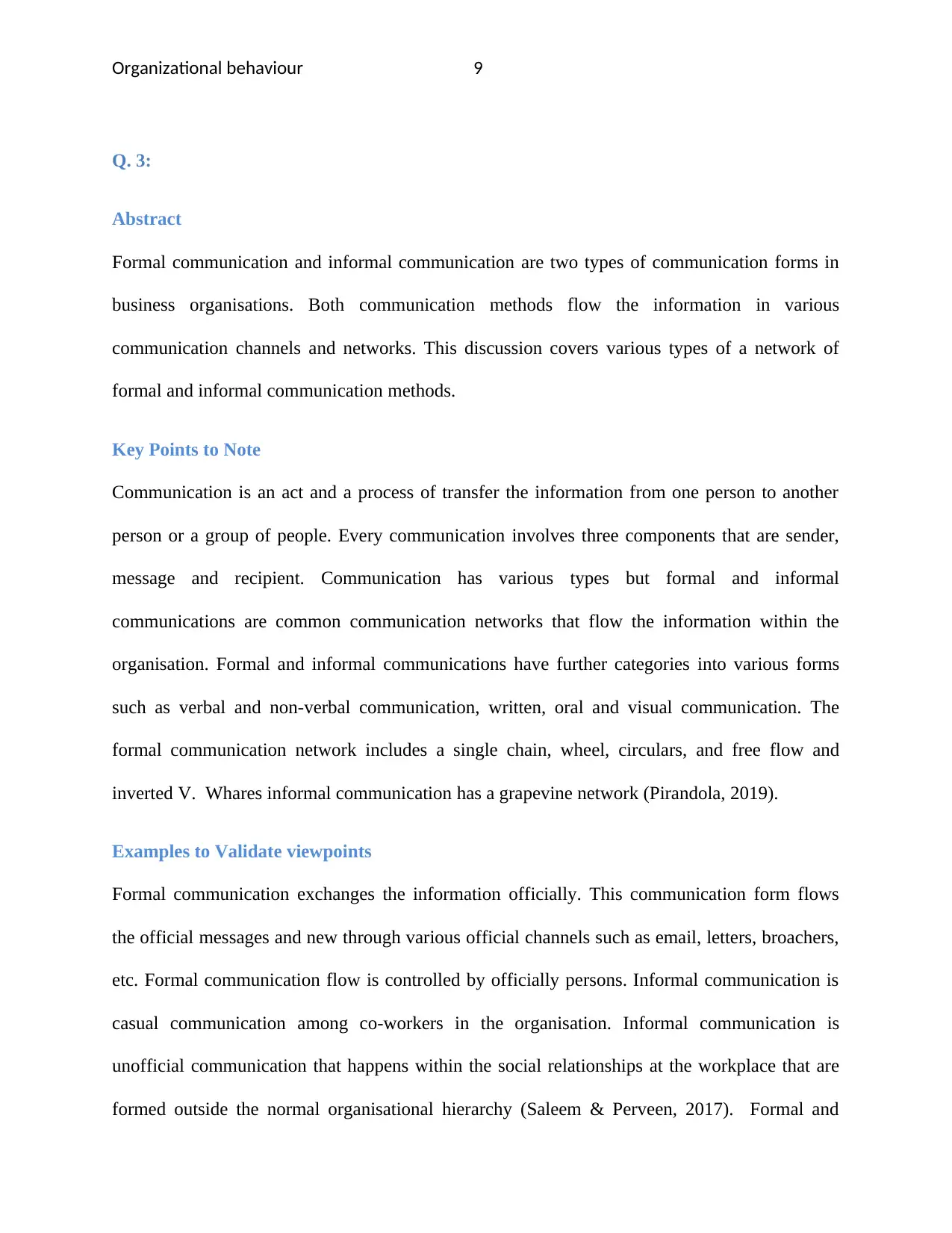
Organizational behaviour 9
Q. 3:
Abstract
Formal communication and informal communication are two types of communication forms in
business organisations. Both communication methods flow the information in various
communication channels and networks. This discussion covers various types of a network of
formal and informal communication methods.
Key Points to Note
Communication is an act and a process of transfer the information from one person to another
person or a group of people. Every communication involves three components that are sender,
message and recipient. Communication has various types but formal and informal
communications are common communication networks that flow the information within the
organisation. Formal and informal communications have further categories into various forms
such as verbal and non-verbal communication, written, oral and visual communication. The
formal communication network includes a single chain, wheel, circulars, and free flow and
inverted V. Whares informal communication has a grapevine network (Pirandola, 2019).
Examples to Validate viewpoints
Formal communication exchanges the information officially. This communication form flows
the official messages and new through various official channels such as email, letters, broachers,
etc. Formal communication flow is controlled by officially persons. Informal communication is
casual communication among co-workers in the organisation. Informal communication is
unofficial communication that happens within the social relationships at the workplace that are
formed outside the normal organisational hierarchy (Saleem & Perveen, 2017). Formal and
Q. 3:
Abstract
Formal communication and informal communication are two types of communication forms in
business organisations. Both communication methods flow the information in various
communication channels and networks. This discussion covers various types of a network of
formal and informal communication methods.
Key Points to Note
Communication is an act and a process of transfer the information from one person to another
person or a group of people. Every communication involves three components that are sender,
message and recipient. Communication has various types but formal and informal
communications are common communication networks that flow the information within the
organisation. Formal and informal communications have further categories into various forms
such as verbal and non-verbal communication, written, oral and visual communication. The
formal communication network includes a single chain, wheel, circulars, and free flow and
inverted V. Whares informal communication has a grapevine network (Pirandola, 2019).
Examples to Validate viewpoints
Formal communication exchanges the information officially. This communication form flows
the official messages and new through various official channels such as email, letters, broachers,
etc. Formal communication flow is controlled by officially persons. Informal communication is
casual communication among co-workers in the organisation. Informal communication is
unofficial communication that happens within the social relationships at the workplace that are
formed outside the normal organisational hierarchy (Saleem & Perveen, 2017). Formal and
Paraphrase This Document
Need a fresh take? Get an instant paraphrase of this document with our AI Paraphraser
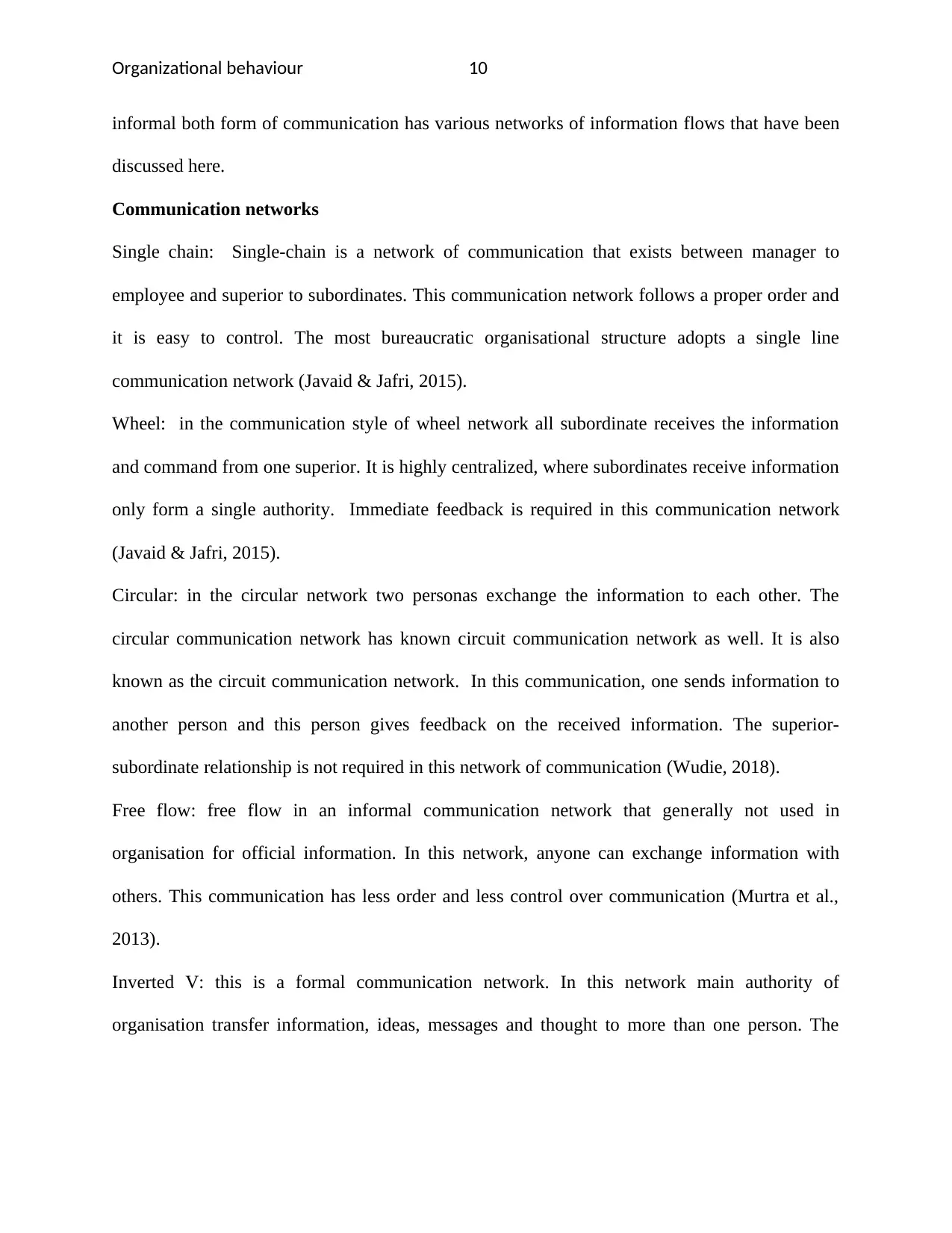
Organizational behaviour 10
informal both form of communication has various networks of information flows that have been
discussed here.
Communication networks
Single chain: Single-chain is a network of communication that exists between manager to
employee and superior to subordinates. This communication network follows a proper order and
it is easy to control. The most bureaucratic organisational structure adopts a single line
communication network (Javaid & Jafri, 2015).
Wheel: in the communication style of wheel network all subordinate receives the information
and command from one superior. It is highly centralized, where subordinates receive information
only form a single authority. Immediate feedback is required in this communication network
(Javaid & Jafri, 2015).
Circular: in the circular network two personas exchange the information to each other. The
circular communication network has known circuit communication network as well. It is also
known as the circuit communication network. In this communication, one sends information to
another person and this person gives feedback on the received information. The superior-
subordinate relationship is not required in this network of communication (Wudie, 2018).
Free flow: free flow in an informal communication network that generally not used in
organisation for official information. In this network, anyone can exchange information with
others. This communication has less order and less control over communication (Murtra et al.,
2013).
Inverted V: this is a formal communication network. In this network main authority of
organisation transfer information, ideas, messages and thought to more than one person. The
informal both form of communication has various networks of information flows that have been
discussed here.
Communication networks
Single chain: Single-chain is a network of communication that exists between manager to
employee and superior to subordinates. This communication network follows a proper order and
it is easy to control. The most bureaucratic organisational structure adopts a single line
communication network (Javaid & Jafri, 2015).
Wheel: in the communication style of wheel network all subordinate receives the information
and command from one superior. It is highly centralized, where subordinates receive information
only form a single authority. Immediate feedback is required in this communication network
(Javaid & Jafri, 2015).
Circular: in the circular network two personas exchange the information to each other. The
circular communication network has known circuit communication network as well. It is also
known as the circuit communication network. In this communication, one sends information to
another person and this person gives feedback on the received information. The superior-
subordinate relationship is not required in this network of communication (Wudie, 2018).
Free flow: free flow in an informal communication network that generally not used in
organisation for official information. In this network, anyone can exchange information with
others. This communication has less order and less control over communication (Murtra et al.,
2013).
Inverted V: this is a formal communication network. In this network main authority of
organisation transfer information, ideas, messages and thought to more than one person. The
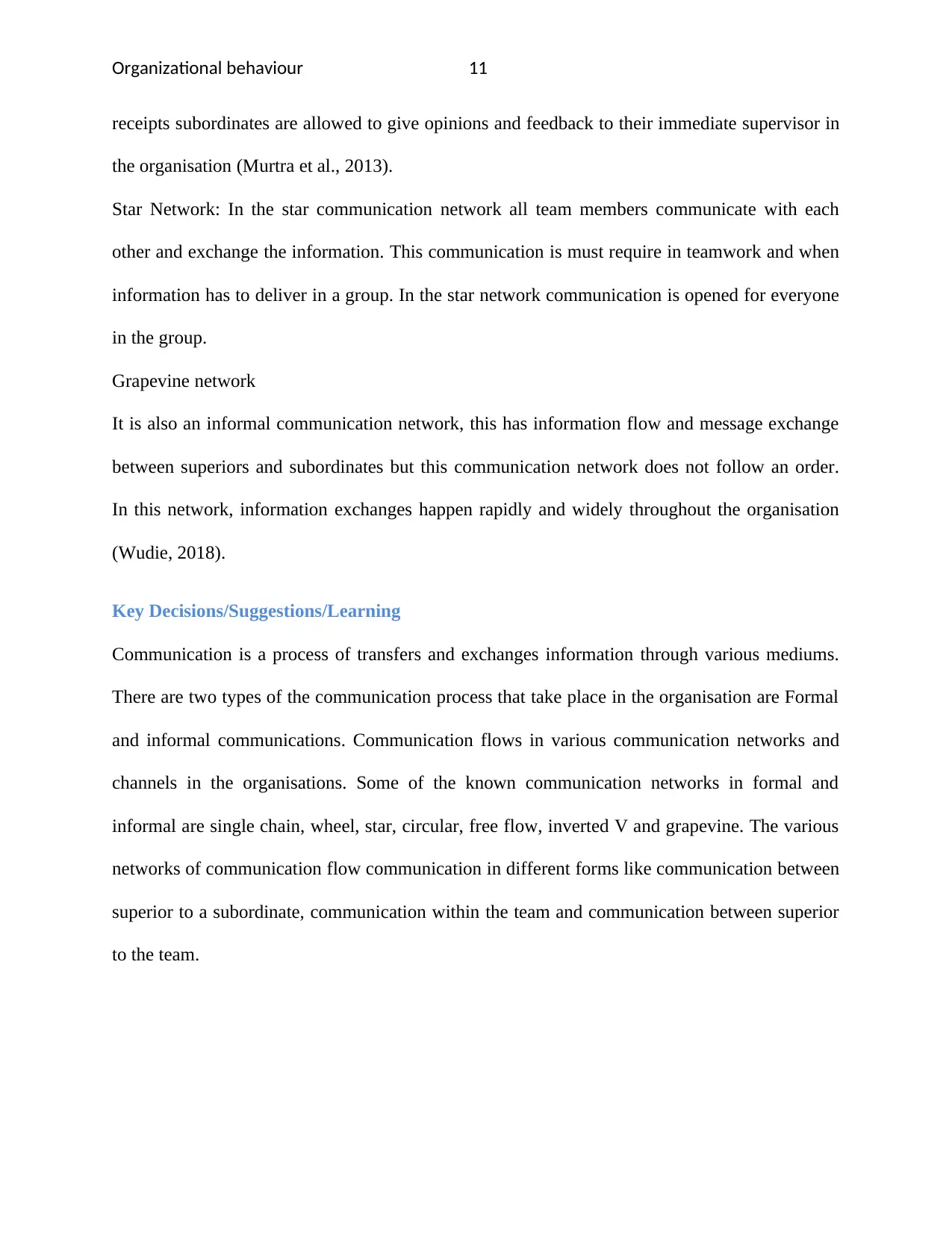
Organizational behaviour 11
receipts subordinates are allowed to give opinions and feedback to their immediate supervisor in
the organisation (Murtra et al., 2013).
Star Network: In the star communication network all team members communicate with each
other and exchange the information. This communication is must require in teamwork and when
information has to deliver in a group. In the star network communication is opened for everyone
in the group.
Grapevine network
It is also an informal communication network, this has information flow and message exchange
between superiors and subordinates but this communication network does not follow an order.
In this network, information exchanges happen rapidly and widely throughout the organisation
(Wudie, 2018).
Key Decisions/Suggestions/Learning
Communication is a process of transfers and exchanges information through various mediums.
There are two types of the communication process that take place in the organisation are Formal
and informal communications. Communication flows in various communication networks and
channels in the organisations. Some of the known communication networks in formal and
informal are single chain, wheel, star, circular, free flow, inverted V and grapevine. The various
networks of communication flow communication in different forms like communication between
superior to a subordinate, communication within the team and communication between superior
to the team.
receipts subordinates are allowed to give opinions and feedback to their immediate supervisor in
the organisation (Murtra et al., 2013).
Star Network: In the star communication network all team members communicate with each
other and exchange the information. This communication is must require in teamwork and when
information has to deliver in a group. In the star network communication is opened for everyone
in the group.
Grapevine network
It is also an informal communication network, this has information flow and message exchange
between superiors and subordinates but this communication network does not follow an order.
In this network, information exchanges happen rapidly and widely throughout the organisation
(Wudie, 2018).
Key Decisions/Suggestions/Learning
Communication is a process of transfers and exchanges information through various mediums.
There are two types of the communication process that take place in the organisation are Formal
and informal communications. Communication flows in various communication networks and
channels in the organisations. Some of the known communication networks in formal and
informal are single chain, wheel, star, circular, free flow, inverted V and grapevine. The various
networks of communication flow communication in different forms like communication between
superior to a subordinate, communication within the team and communication between superior
to the team.
⊘ This is a preview!⊘
Do you want full access?
Subscribe today to unlock all pages.

Trusted by 1+ million students worldwide
1 out of 25
Related Documents
Your All-in-One AI-Powered Toolkit for Academic Success.
+13062052269
info@desklib.com
Available 24*7 on WhatsApp / Email
![[object Object]](/_next/static/media/star-bottom.7253800d.svg)
Unlock your academic potential
Copyright © 2020–2025 A2Z Services. All Rights Reserved. Developed and managed by ZUCOL.





